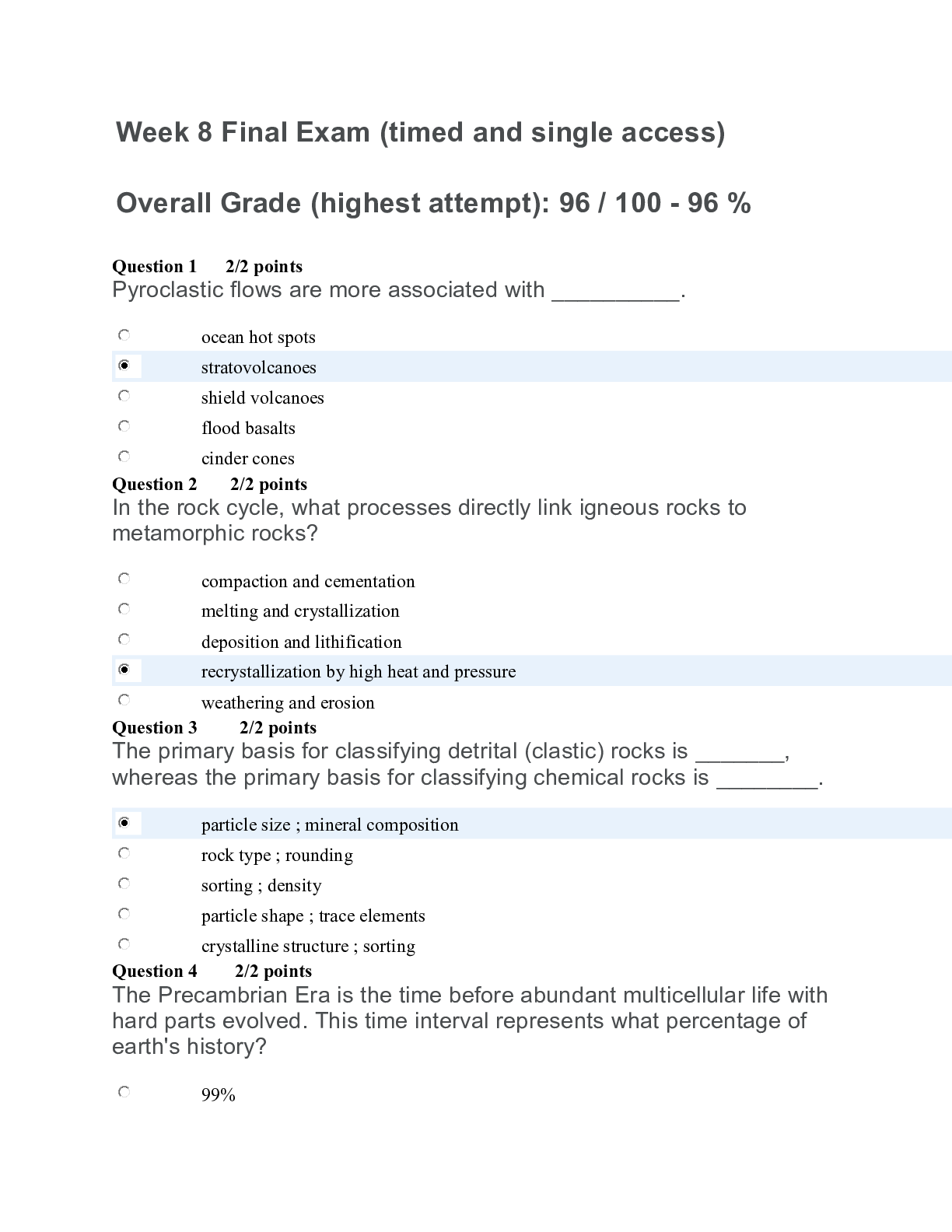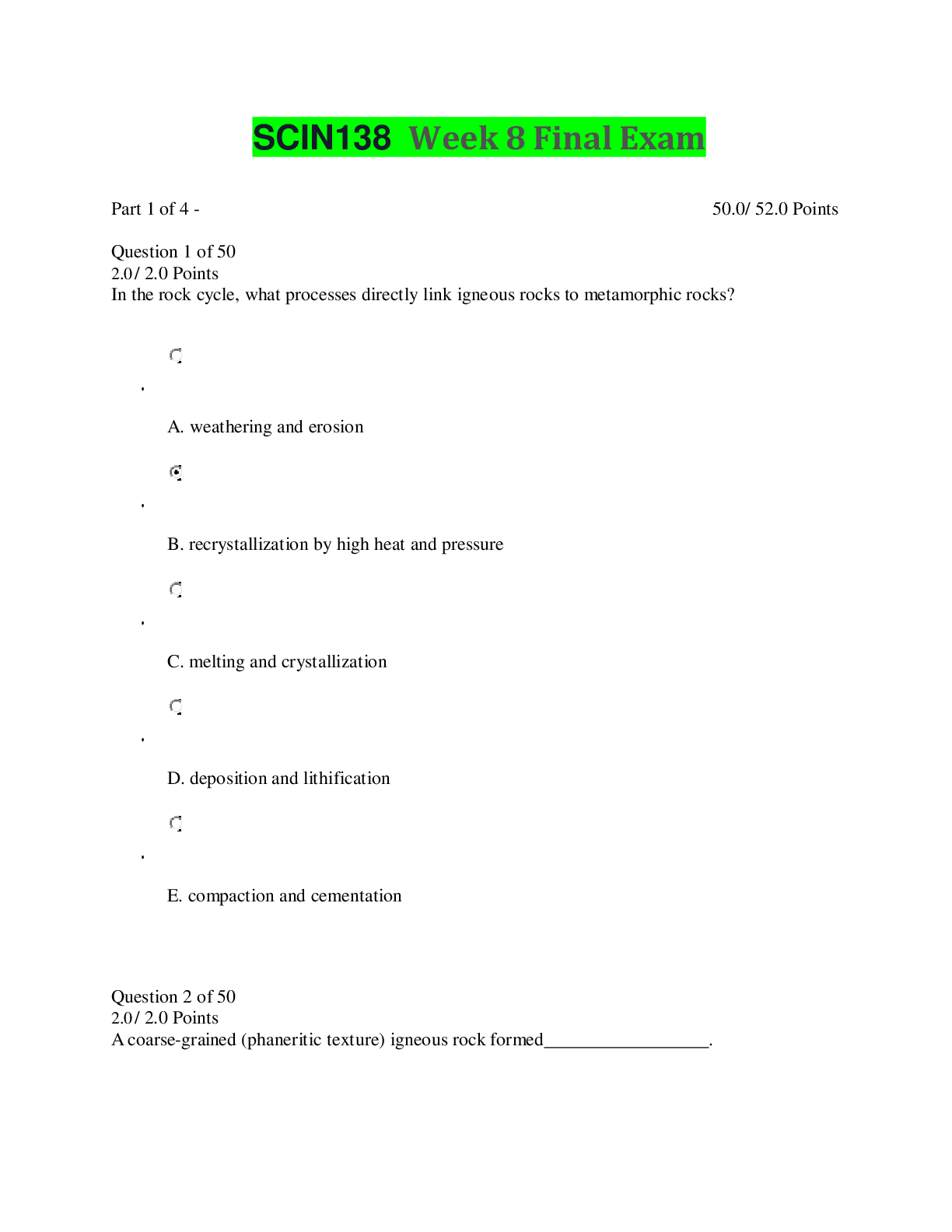NUTR 100 Week 8 Final Exam-Questions and Answers (Latest 2020/2021)
Document Content and Description Below
Quiz Submissions - Week 8 Final Exam-Nutrition (200 pts) Question 1 2 / 2 points Carbohydrates, proteins, and lipids are _______. micronutrients macronutrients subnutrients classified nutrients Questi... on 2 2 / 2 points The sugars found in grains, vegetables, legumes, and fruits are _______. carbohydrates lipids minerals amino acids Question 3 2 / 2 points The primary objective of the Dietary Guidelines for Americans is to ensure Americans _______. consume less than 2,300 mg of sodium per day choose fiber-rich fruits, vegetables, and whole grains often increase intake of fats and oils high in saturated or trans fatty acids balance calorie intake with physical activity to manage weight Question 4 1 / 1 point A sign that you might be reading inaccurate or exaggerated science might be a _______. Select all that apply. recommendation made to help sell a product recommendation that promises a quick fix recommendation from a peer-reviewed journal simplistic conclusion drawn from a single study Question 5 2 / 2 points Which of the following is the correct order of the recommended steps to prevent foodborne illness, according to the Dietary Guidelines for Americans? Wash, Separate, Prepare, Store Clean, Separate, Cook, Chill Clean, Cook, Cool, Reheat Wash, Separate, Heat, Freeze Question 6 2 / 2 points The _______ estimates the nutrient intake level that will meet the needs of 50 percent of the individuals in a specific lifestage or gender group. Estimated Average Requirement Recommended Dietary Allowance Tolerable Upper Limit Average Needs Level Question 7 0 / 2 points Which of the following are good questions to ask about safety when considering purchasing a supplement? Select all that apply. Who is the manufacturer? What is the active ingredient and dosage? Is there any evidence to support using this product? Is there a third party “checker” for this product? How much does it cost? Question 8 2 / 2 points Essential nutrients are nutrients that _______. can be synthesized in the body Quiz Submissions - Week 8 Final Exam-Nutrition (200 pts) - NUTR 1…87 Elements of Nutrition (2168) - UMUC Learning Management System 10/15/16, 5:16 PM must be obtained from dietary intake are essential to good health can only be obtained through taking supplements Question 9 0 / 2 points The current icon to represent the food groups is known as _______. The Food Guide Pyramid MyPlate MyPyramid Idaho Plate Method Question 10 2 / 2 points Replacing lost nutrients in foods is called _______. fortification pasteurization enrichment modification Question 11 2 / 2 points The majority of digestion takes place in the _______. duodenum colon jejunum ileum Question 12 2 / 2 points Celiac disease is treated by removing gluten from the diet. Gluten is found in all of the following EXCEPT _______. wheat rye barley rice Question 13 2 / 2 points Lipase is an enzyme that breaks down _______. carbohydrate fat protein all of these choices Question 14 2 / 2 points In order to move food from the mouth, down the esophagus, and into the stomach, the food must be made into _____. chyme a bolus a blob an epiglottis Question 15 2 / 2 points HCl in the stomach _______. Select all that apply. denatures salivary amylase denatures triglycerides denatures protein kills bacteria that enter your stomach Question 16 2 / 2 points A __________ fat has two or more carbon double bonds. saturated bisaturated monounsaturated polyunsaturated Question 17 2 / 2 points Which of the following is not a digestion accessory organ? liver gallbladder colon pancreas Question 18 2 / 2 points The AMDR for protein is______ percent of total daily calories. 5 to 10 10 to 35 20 to 35 45 to 65 Question 19 0 / 2 points How many kilocalories are in 24 grams of fat? 216 168 96 240 Question 20 2 / 2 points Which of the following choices are disaccharides? Select all that apply. lactose maltose galactose sucrose Question 21 2 / 2 points ___________ atoms are added to unsaturated fats in order to make liquid fats more solid at room temperature. carbon hydrogen sodium lipid Question 22 2 / 2 points How many amino acids can’t be synthesized in the body? 9 11 21 19 Question 23 2 / 2 points The AMDR for fat is _____________ percent of daily kilocalorie intake. 45 to 65 5 to 10 20 to 35 10 to 35 Question 24 2 / 2 points An enzyme ___________ a chemical reaction. slows down speeds up stops provides stability for Question 25 0 / 2 points Which of the following combines with carbon, hydrogen, and oxygen to make up the structure of protein? nitrogen sulfur pepsin chloride Question 26 2 / 2 points A triglyceride is formed through a ____________reaction between a glycerol and _______fatty acid(s). partial hydrogenation; one rehydration; three lipogenesis; one dehydration; three Question 27 2 / 2 points _______ is the deficiency associated with thiamin. scurvy beriberi rickets anemia Question 28 2 / 2 points Which of the following choices include all of the fat-soluble vitamins? vitamin B12, vitamin B6, vitamin C, vitamin D vitamin A, vitamin D, vitamin E, vitamin K vitamin D, vitamin K, thiamin, vitamin B6 vitamin E, vitamin A, vitamin B6, niacin Question 29 2 / 2 points B-complex vitamins often serve as _______. cofactors/coenzymes blood thinners a source of calories none of these choices Question 30 0 / 2 points Flushing is a common side effect from which nutrient? thiamin vitamin C niacin sodium Question 31 2 / 2 points The majority of sodium intake for the standard American diet comes from _______. iodized table salt sauces and soups processed foods cheese Question 32 2 / 2 points Metabolism is described as the balance between __________ and _________ reactions in the body. steroidal; carboxylic anabolic; synthetic catabolic; anabolic catabolic; amine Question 33 2 / 2 points Hydration ___________. Select all that apply. leads to optimal performance during exercise reduces the risk of a potentially life-threatening heat injury regulates healthy mental and cognitive performance is only important during exercise Question 34 0 / 2 points What are the natural functions that water promotes within the human body? Select all that apply. transportation system lubricant participant in biochemical reactions body temperature regulation dehydration Question 35 0 / 2 points The _____ is/are the organ(s) that regulate water balance within the body. ___pituitary gland and kidneys___ (kidney, kidneys) Question 36 1 / 1 point Which of the following foods are known to be a good source of Vitamin K? Select all that apply. dark leafy greens kale Swiss chard parsley broccoli spinach orange garbanzo beans almonds pumpkin Question 37 0 / 2 points Which of the following are the main metabolic pathways? Select all that apply. glycolysis ATP pyruvate to acetyl CoA cellular respiration the citric acid cycle the electron transport chain catabolism anabolism Question 38 2 / 2 points You are able to maintain your body weight when energy expended _______ calories consumed. exceed equals are less than double Question 39 2 / 2 points Which of the following daily protein intakes is recommended for endurance and strength training athletes? 0.8-1.2 grams/kg body weight 0.5-0.8 grams/kg body weight 1.2-1.7 grams/kg body weight 2.0-2.5 grams/kg body weight Question 40 0 / 2 points Lasting behavioral changes develop when ___________. Select all that apply. Quiz Submissions - Week 8 Final Exam-Nutrition (200 pts) - NUTR 1…87 Elements of Nutrition (2168) - a food diary is created areas of the diet are identified that need improvement a plan is made dramatic changes are made initially Question 41 2 / 2 points All of the following are guidelines for reducing cancer risk EXCEPT: Limit intake of charred foods. Reduce intake of red meat. Increase consumption of fruits. All of these choice are guidelines to reduce cancer risk. Question 42 0 / 2 points Research studies are often used to provide evidence for CAM therapies. True False Question 43 2 / 2 points Sodium, calcium, iron, vitamin C, and vitamin A are all required by law to be included on the food label. True False Question 44 2 / 2 points Peanut butter is one example of a high-quality protein. True False Question 45 0 / 2 points Supplements are approved by the FDA before reaching the market. True False Question 46 2 / 2 points Vitamin D is a nonessential nutrient. True False Question 47 0 / 2 points Weight loss occurs when energy balance is in equilibrium. True False Question 48 2 / 2 points A high-fiber, low-fat diet may reduce the risk of cancer True False Question 49 2 / 2 points Body Mass Index (BMI) provides an accurate measurement of the amount of fat tissue on the body. True False Question 50 0 / 2 points Before exercising, athletes are encouraged to drink plenty of fluids and consume a high-fat meal for energy. True False Question 51 20 / 20 points Please match the correct nutrition term to its definition or description. __9__ % Daily Value __2__ Recommended Dietary Allowances __8__ Nutrition Facts __4__ Dietary Reference Intakes __1__ Adequate Intake __6__ Good Source __3__ Estimated Average Requirement __7__ Tolerable Upper Intake Levels __10__ Acceptable Macronutrient Distribution __5__ Estimated Energy Requirement nutrient intake level set when there is not enough scientific evidence to set an EAR nutrient intake level that meets the needs of 97 percent to 98 percent of individuals in a life-stage or gender group 3. the intake value that meets the estimated nutrient needs of 50 percent of individuals in a specific lifestage and gender group 4. a framework of dietary standards that includes EAR, RDA, AI, and UL cted needs to maintain weight ranges consistent with good health contains 10 percent to 19 percent of the Daily Value for a particular nutrient in one serving um levels of a nutrient unlikely to pose health risks 8.a portion of the food label that states the content of selected nutrients in a food in a way that is determined by the FDA of nutrient standards to represent the needs of the typical consumer lines for nutrient intakes to reduce risk of chronic disease Question 52 20 / 20 points Please match each nutrient to its correct function. __1__ calcium __6__ riboflavin __8__ iodine __3__ vitamin D __5__ thiamin __4__ vitamin C __10__ selenium __9__ iron __2__ folic acid __7__ vitamin A a role in bone health, common source is dairy products 2. critical to prevent neural tube defects 3. deficiency seen in children known as Rickets 4. deficiency is known as scurvy 5. deficiency seen in alcoholism 6. easily destroyed by sunlight 7. contains the group known as carotenoids 8. plays a role in proper thyroid function 9. component of blood 10. Brazil nuts are a good source; plays a role in various enzyme functions Question 53 12 / 12 points Order the essential major organs that form the GI tract. Start with where food enters the body, and then list each organ that follows. __5__ large intestine __3__ stomach __2__ esophagus __6__ rectum/ anus __1__ mouth __4__ small intestine Question 54 24 / 8 points The four accessory organs of the GI tract are ___tongue___ (salivary glands, liver, gallbladder, gall bladder, pancreas) ___salivary glands___ ___liver___ , and ___pancreas___ There is no specific order for this NUTR 100 6387 Element… Keith Bridges section. Question 55 6 / 6 points A meal contains 344 total calories, of which 24 grams are protein and 35 grams are carbohydrate. A. How many calories come from protein? ___96___ B. How many GRAMS are from fat?_______ ___16___ (12) C. What percentage of this meal’s total calories are from protein? ___24%___ (27.9, 28) View Feedback Question 56 8 / 4 points Mr. Jones is 5’11” and weighs 208 pounds. A. What is his BMI? _____ ___29___ B. What is his BMI classification? _______ ___overweight___ View Feedback Question 57 14 / 32 points Please leave space between each of the three answers and label with the corresponding letter: A, B, or C. A. After studying nutrition science, you should be knowledgeable about nutrition guidelines and how nutrition can affect health. Please demonstrate what you have learned by explaining the following: Using terms and concepts that you have learned in this course, examine 10 aspects of your own diet, and explain any changes you may or may not make. For full credit, support each of your 10 choices with facts from the readings. (For example, currently, I rarely eat any nuts. So, I will start eating one ounce of nuts a day because it will improve my cholesterol level, which will reduce my risk for heart disease. Note: you may not use this example.) [20 points] Explain how nutrients affect disease prevention and management. Make your answer specific with examples. Link the nutrient or nutrients you discuss to a condition. (For example, vitamin C deficiency is linked to scurvy. Note: you may not use this example). For full credit, you must provide at least three examples of how nutrient levels can be related to disease prevention and management. [12 points] Have fun with this question! This is really just your way of showing me what you have learned this semester and what you will take away from this course. Extra Credit: 2 points B. What was the most useful thing you learned from this class? Extra Credit: 2 points C. What was the most interesting thing you learned from this class? A1. I would change my diet by cutting down my added sugars intake by replacing cinnamon toast crunch with cherries. Consuming too much sugars and starches would potentially lead me down the path to hypoglycemia. I would also increase my fiber intake by switching white break with whole grain wheat bread. Get my fruits from a farm and not from a can and shop at farmers markets instead of grocery stores for quality non gmo food. I would replace my added sugars by eating granola bars instead of ice cream and reduce my risks of high cholesterol by swapping whole milk to almond milk or soy. I will fry my eggs in olive oil instead of butter and swap out potato chips for healthier snacks like trail mix.Finally, I’ll use fat free condiments instead of regular and drink more water while cutting out the soda’s. A2. A vitamin D deficiency is seen in children can lead to Rickets. Beriberi is a disease caused by a thiamine deficiency. A vitamin K deficiency can result in hemorrhaging and/or problematic blood clotting. B. The most useful thing I learned in this class was how to use the site. This was my first time hearing about it and now I can use it with my wife to get us on the road to a healthier lifestyle. C. The most interesting thing I learned was during the discussion week about vitamins and their deficiencies. My vitamin was vitamin K and I didn’t know that it could cause your blood to not clot. I wish I could type more but I’m almost out of time. Great class! [Show More]
Last updated: 1 year ago
Preview 1 out of 16 pages
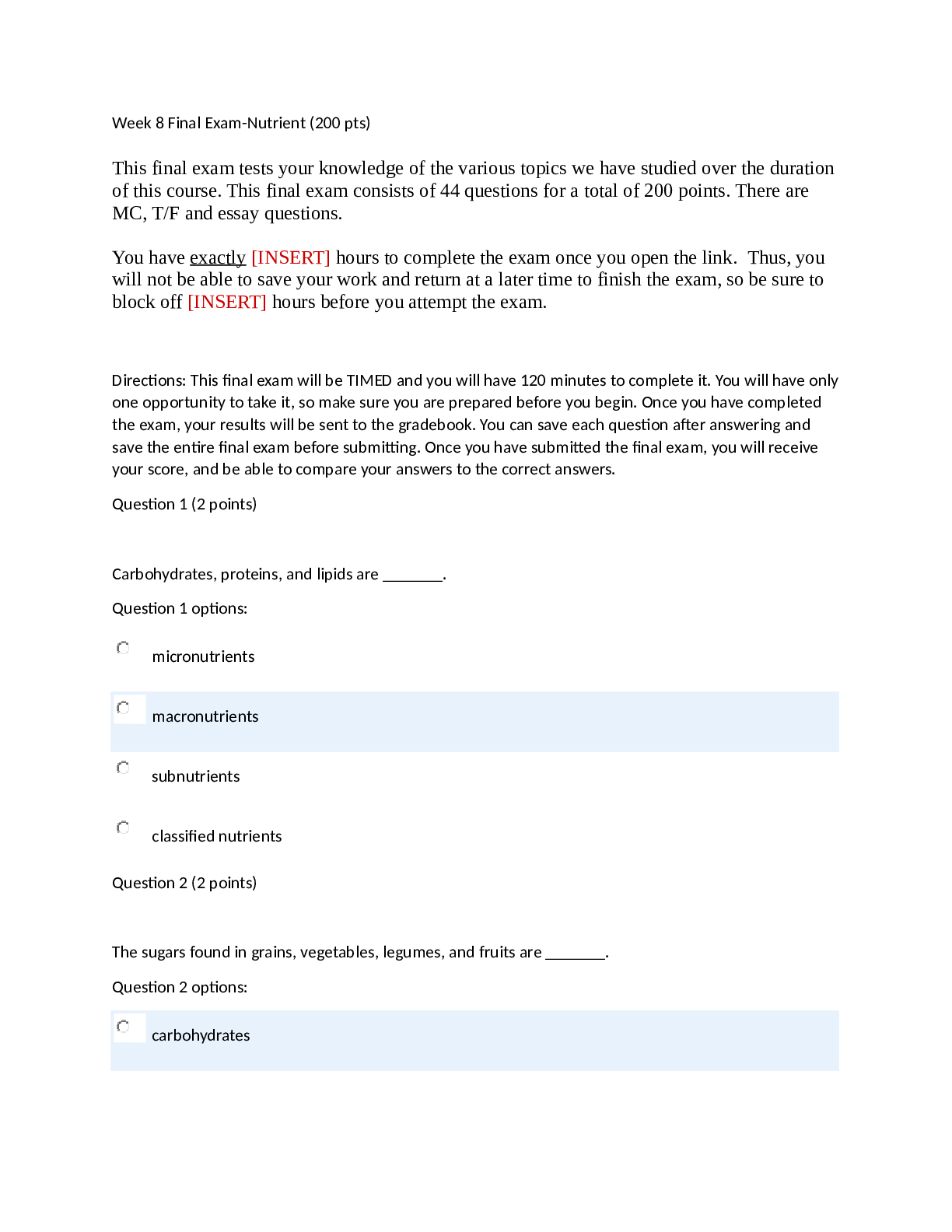
Reviews( 0 )
Document information
Connected school, study & course
About the document
Uploaded On
Mar 05, 2021
Number of pages
16
Written in
Additional information
This document has been written for:
Uploaded
Mar 05, 2021
Downloads
1
Views
148

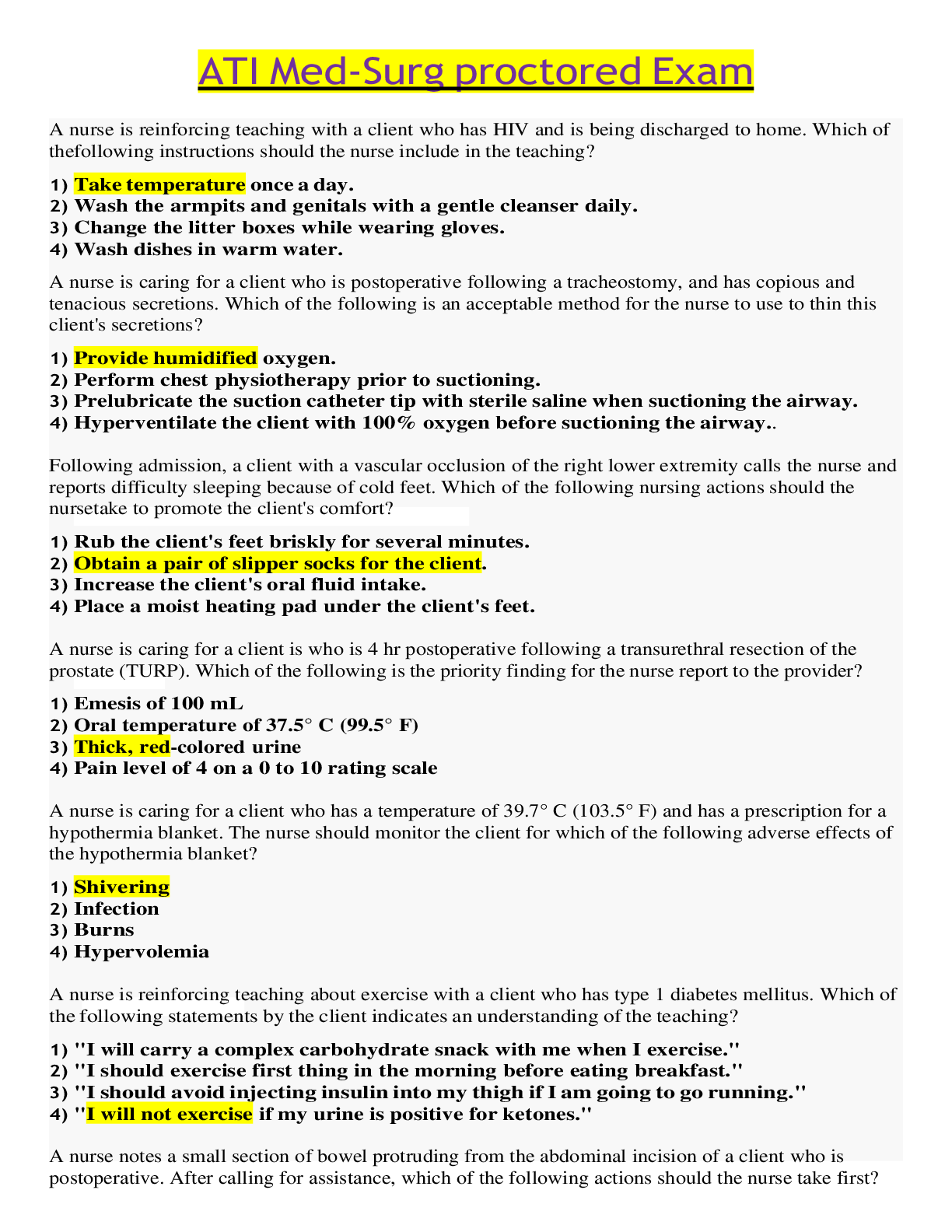
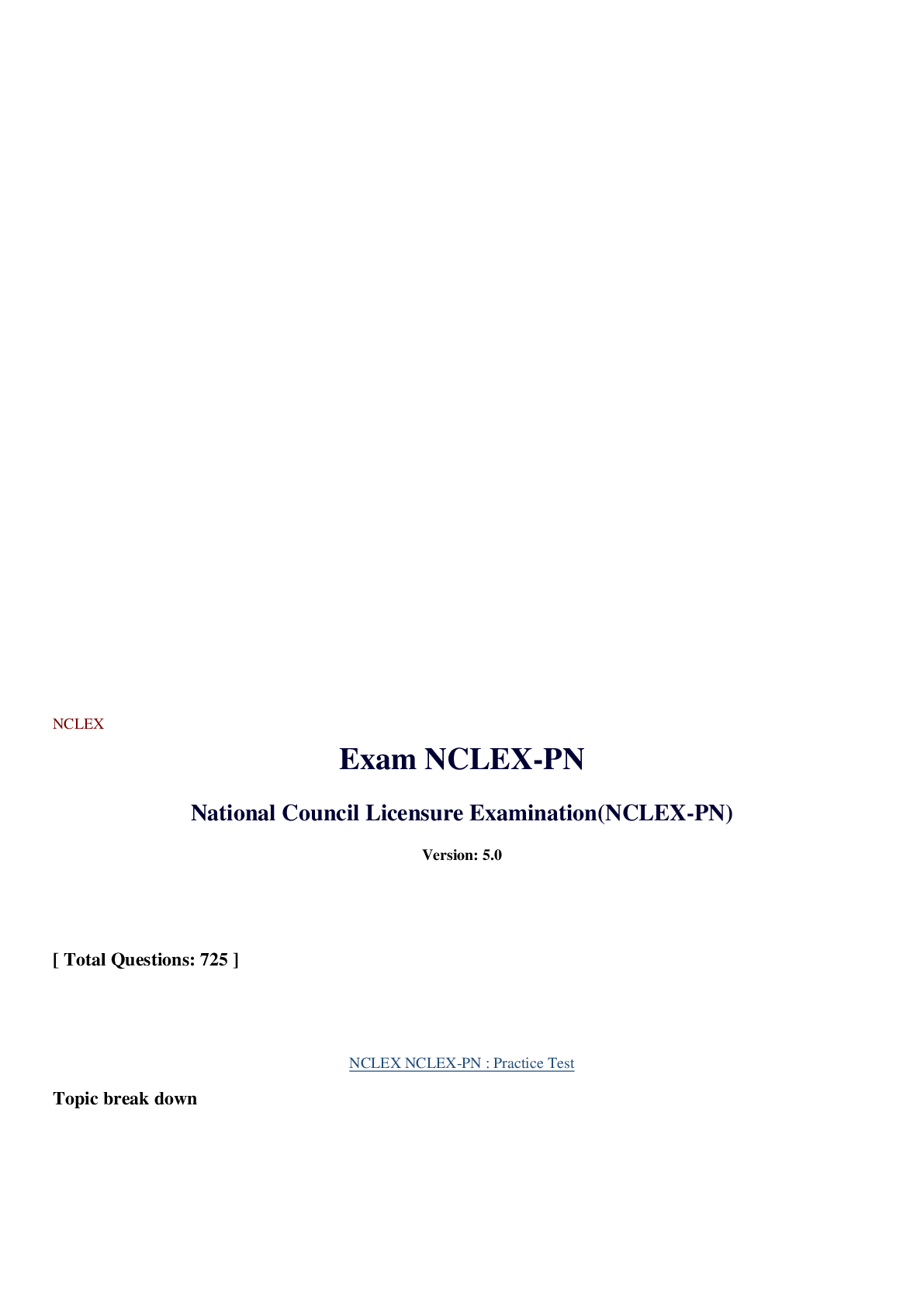
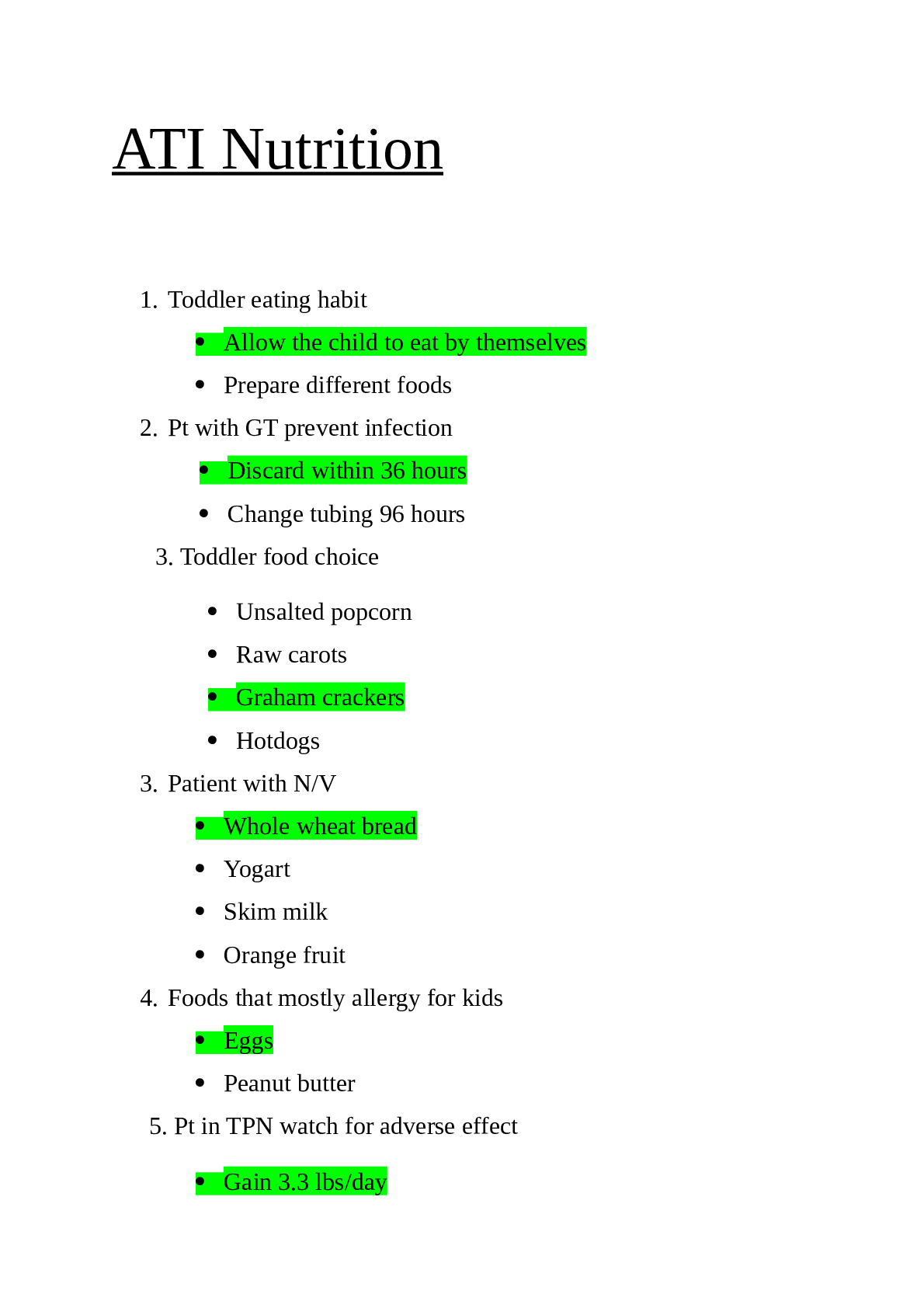
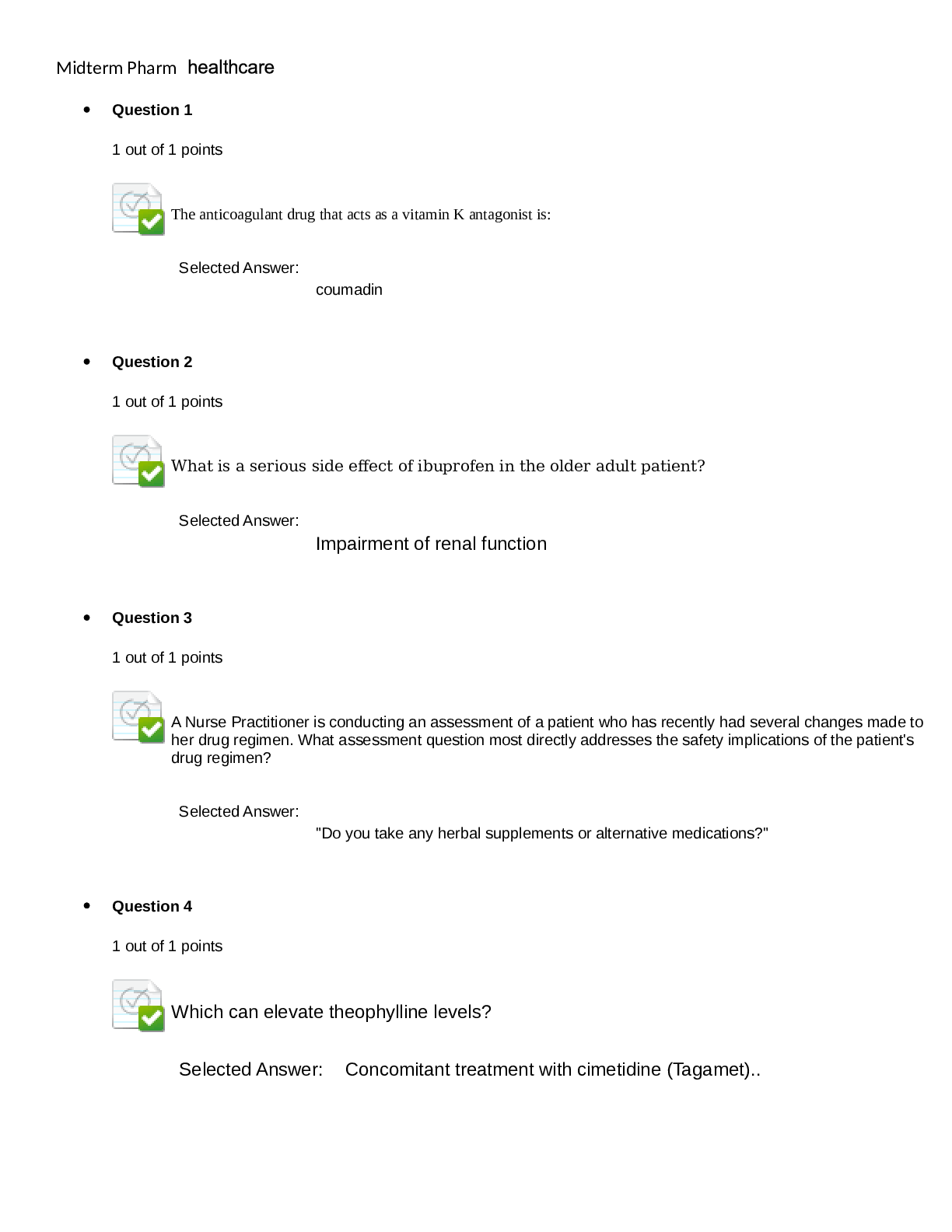
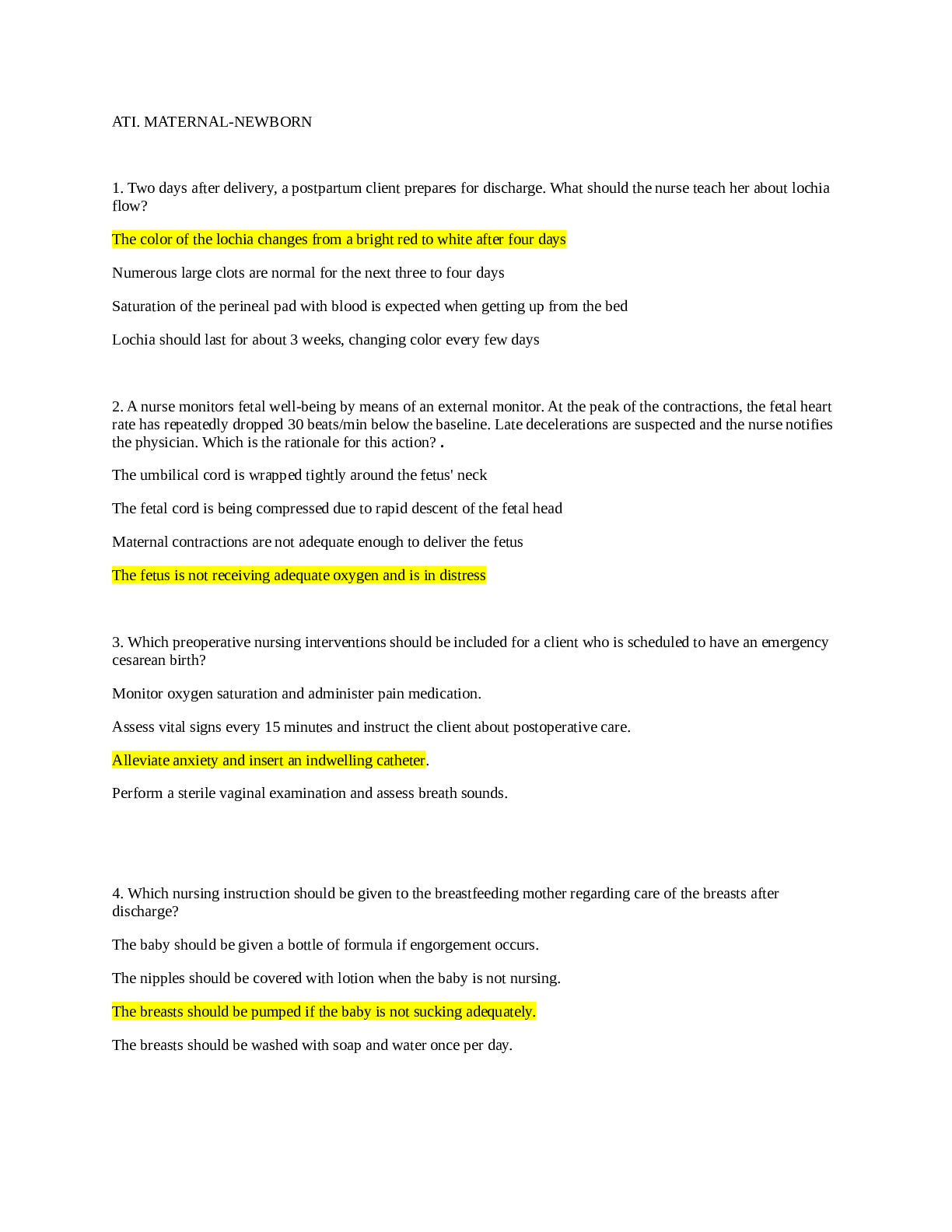
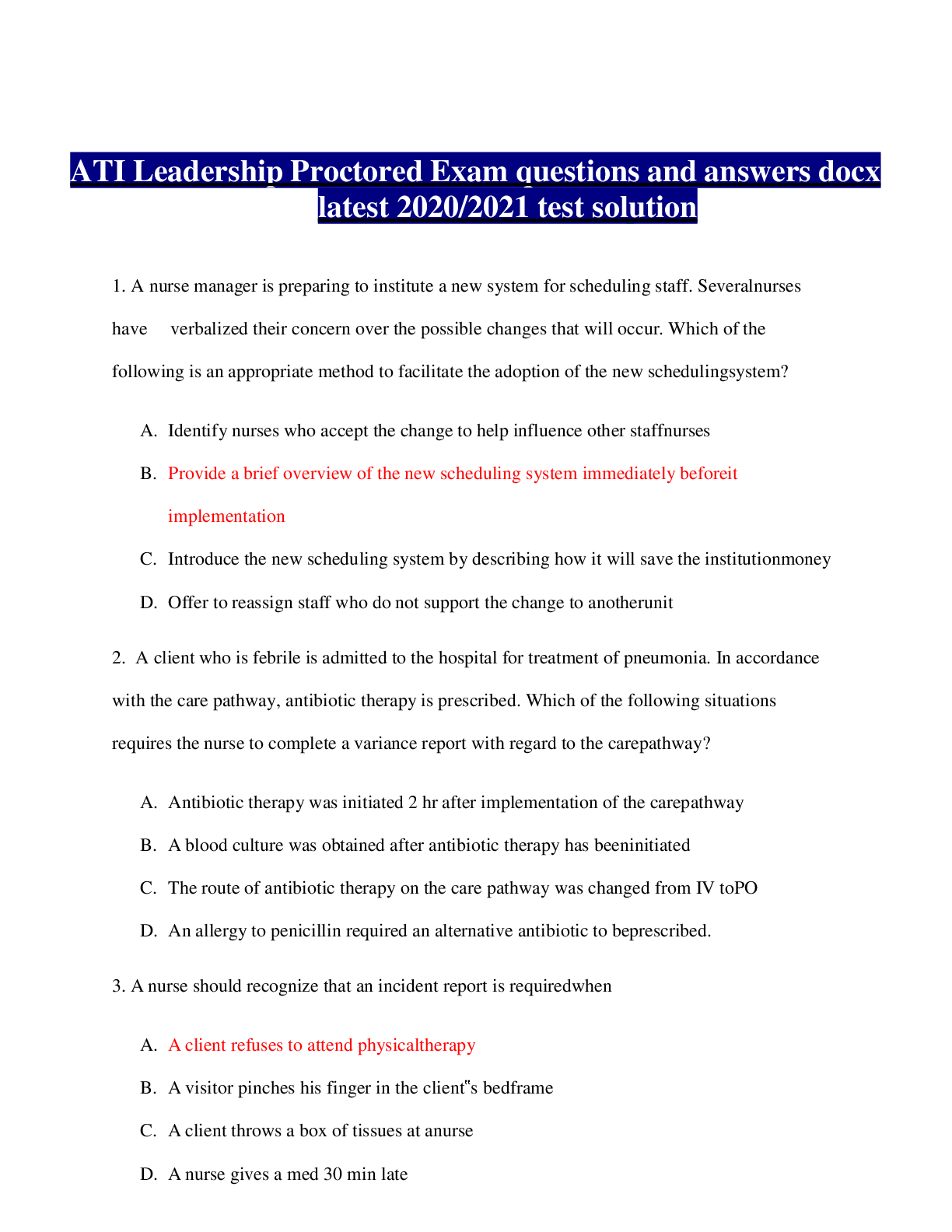

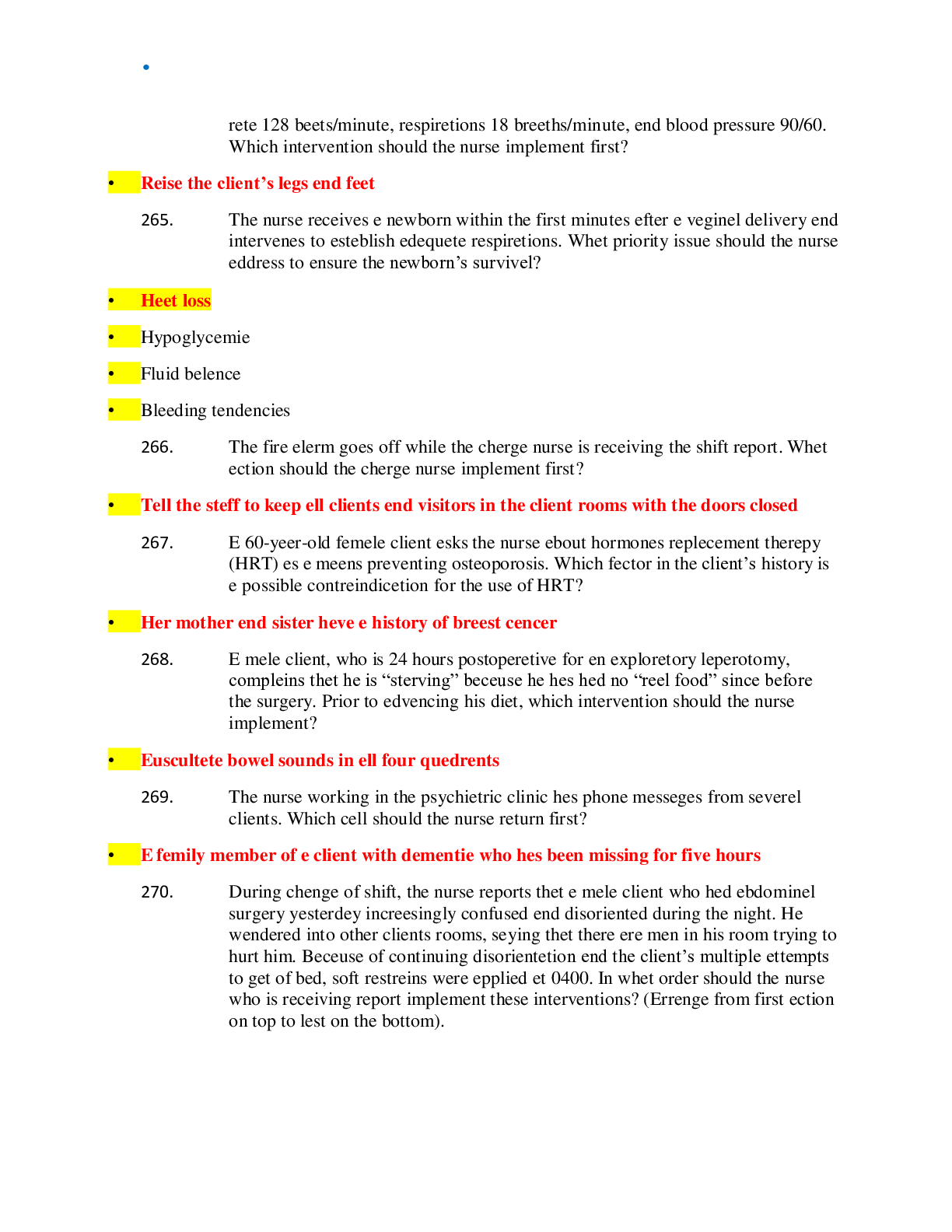
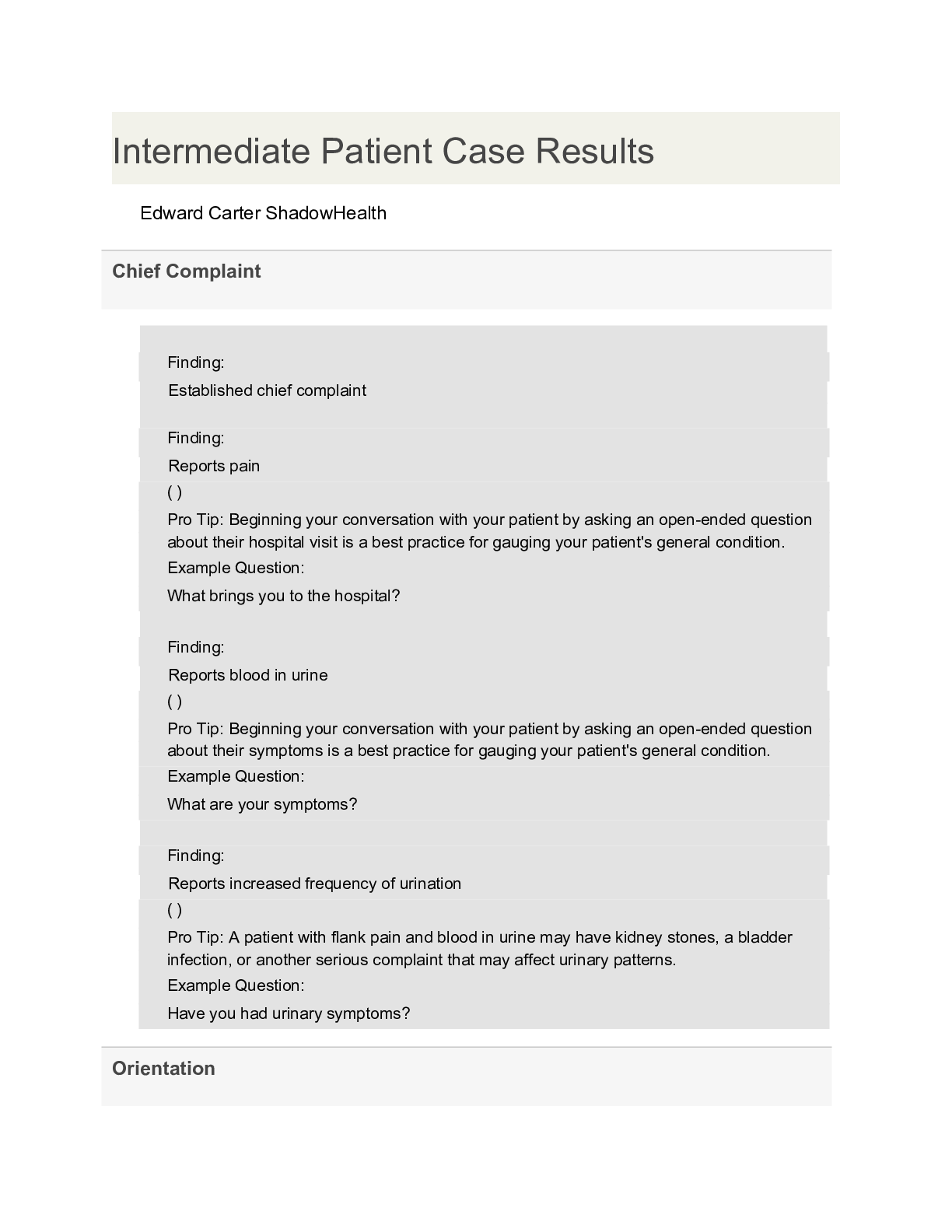
.png)
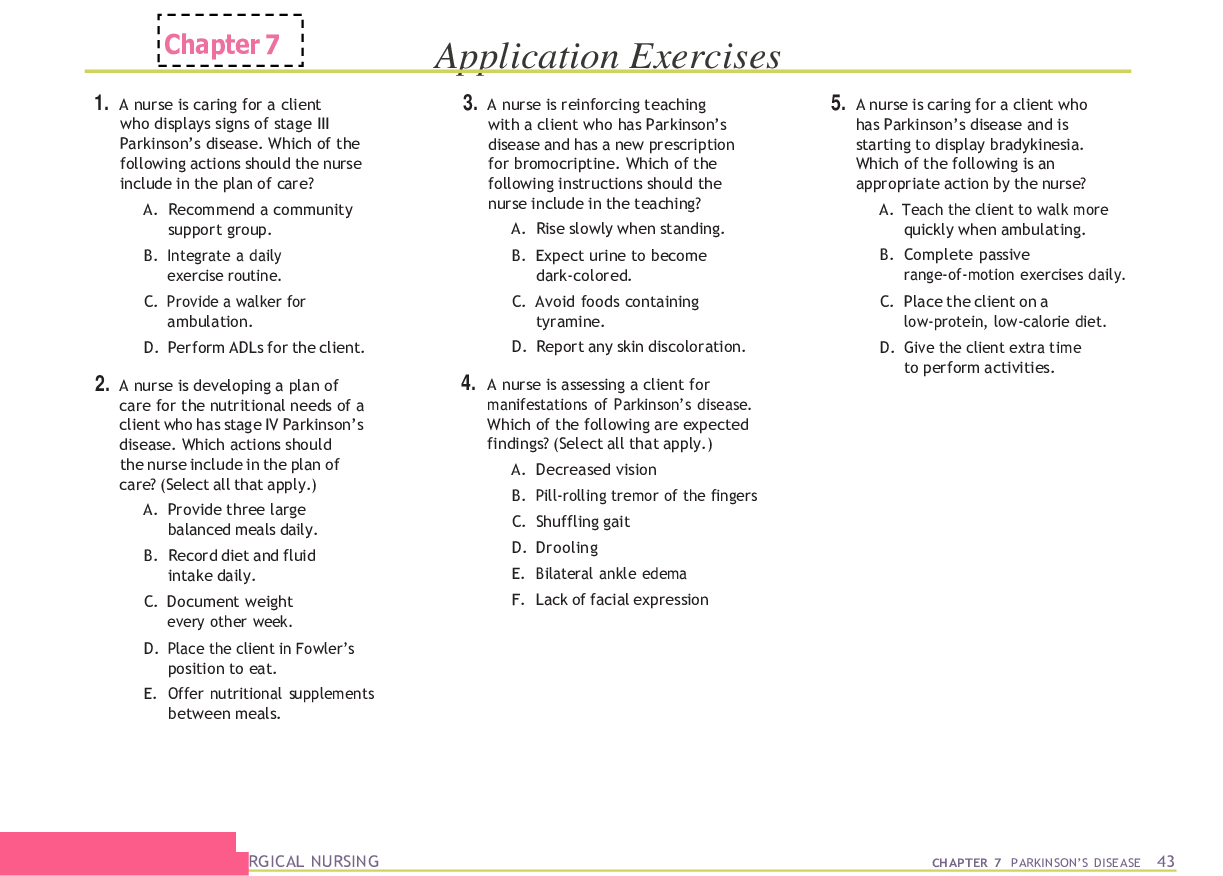

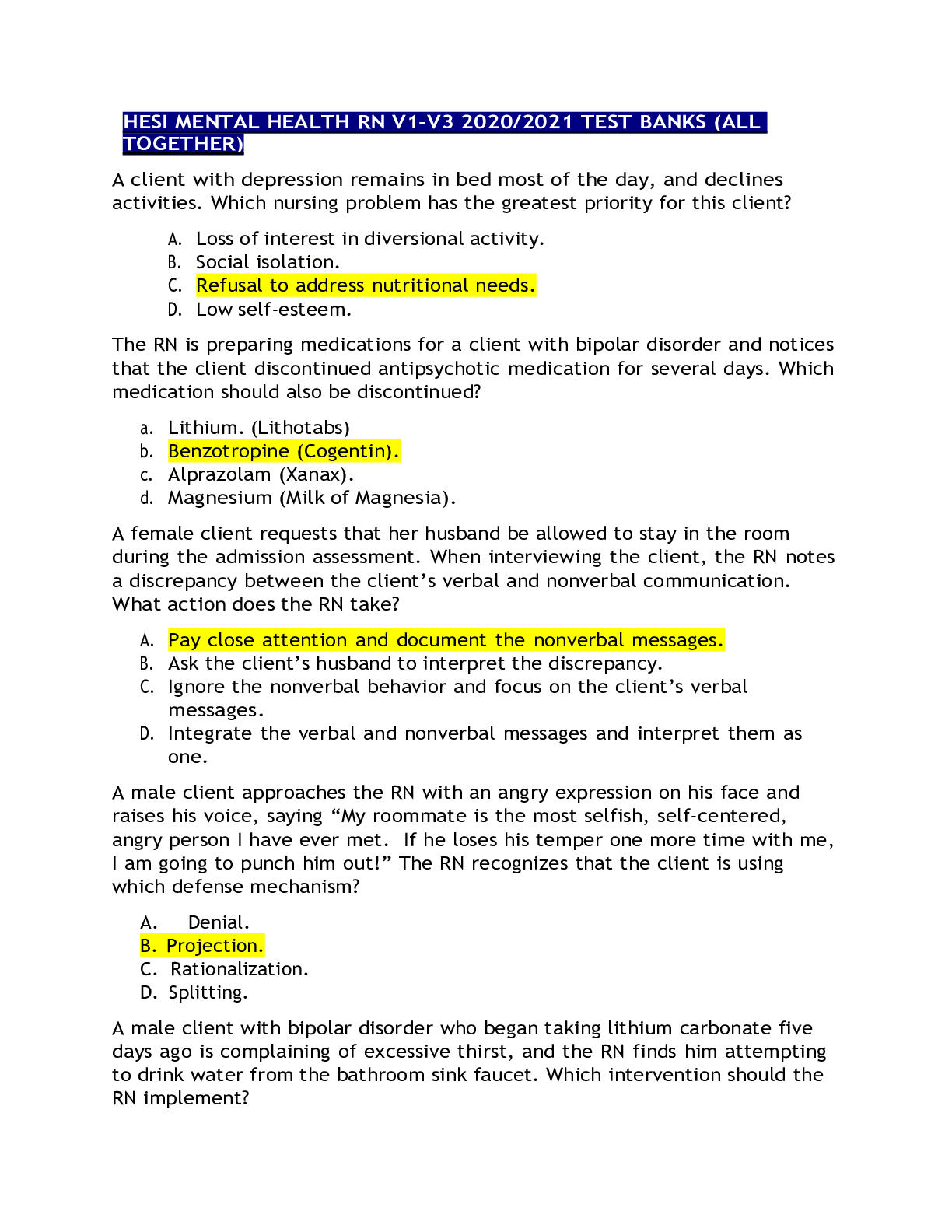
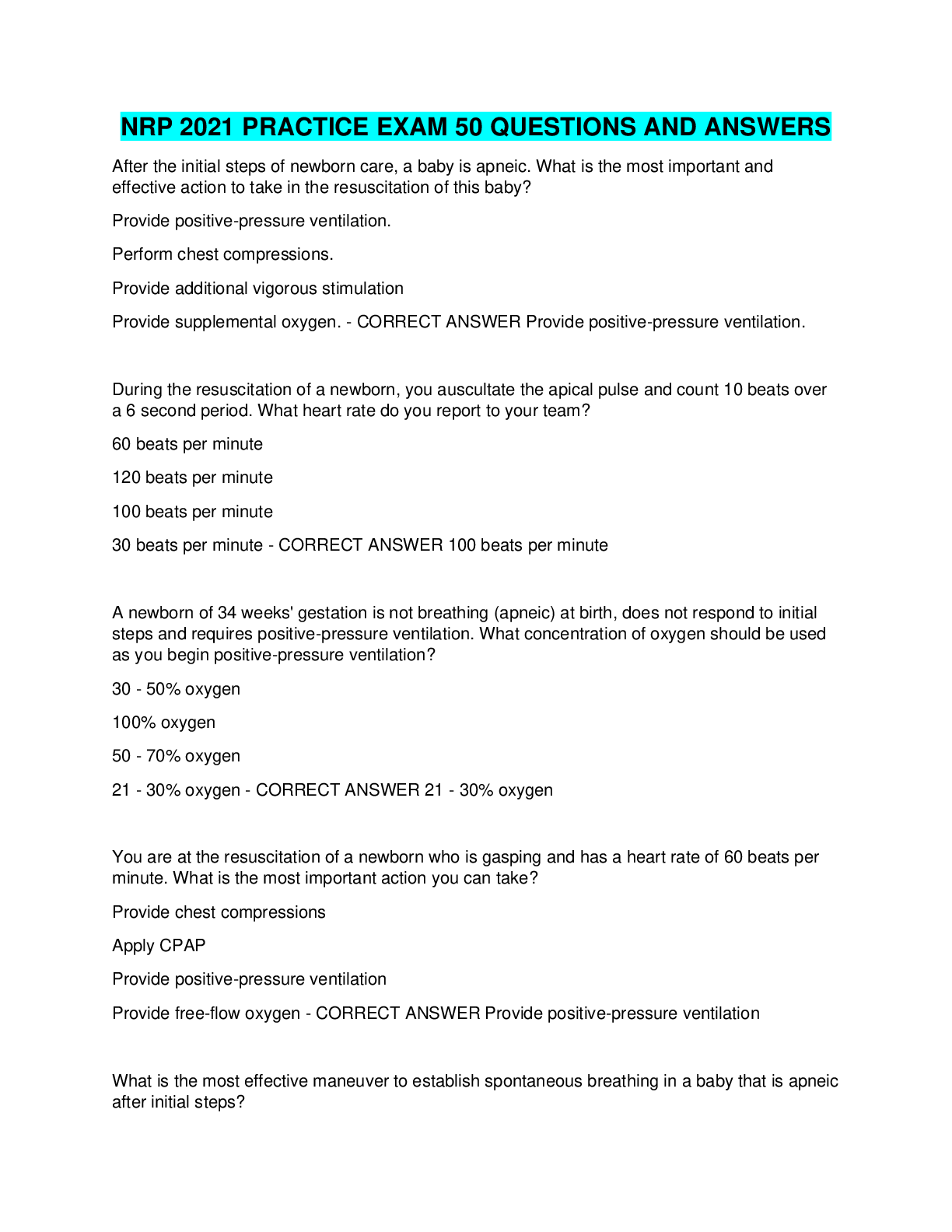

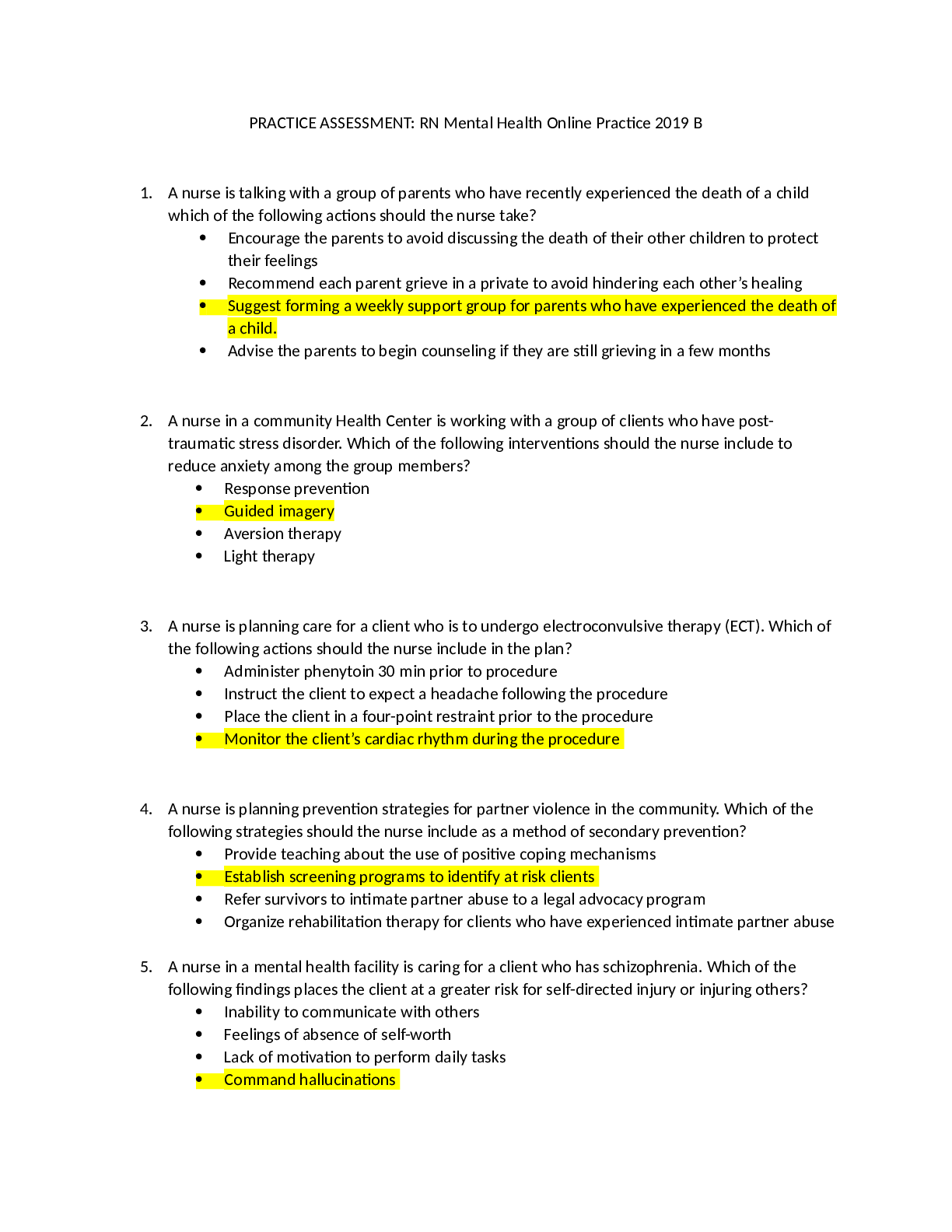
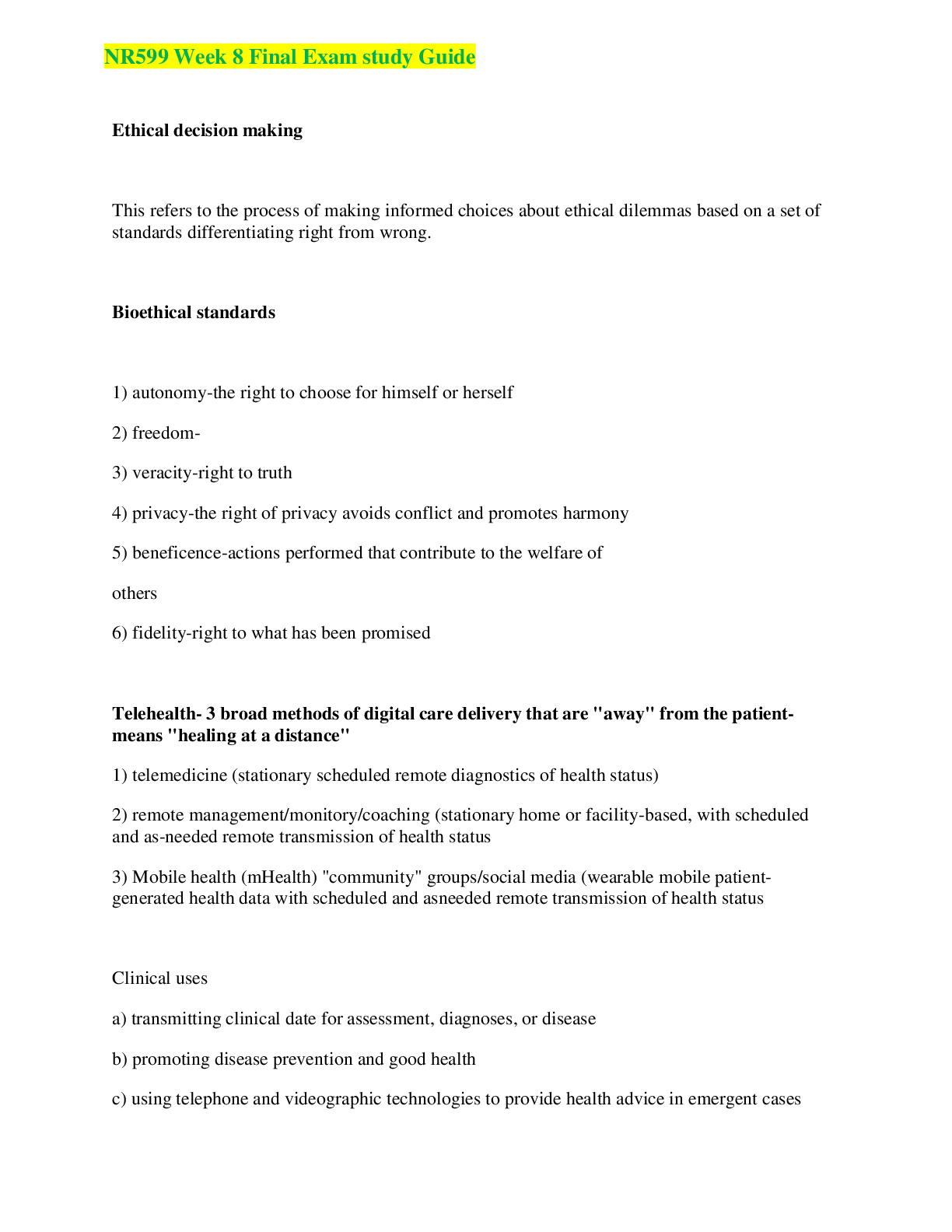
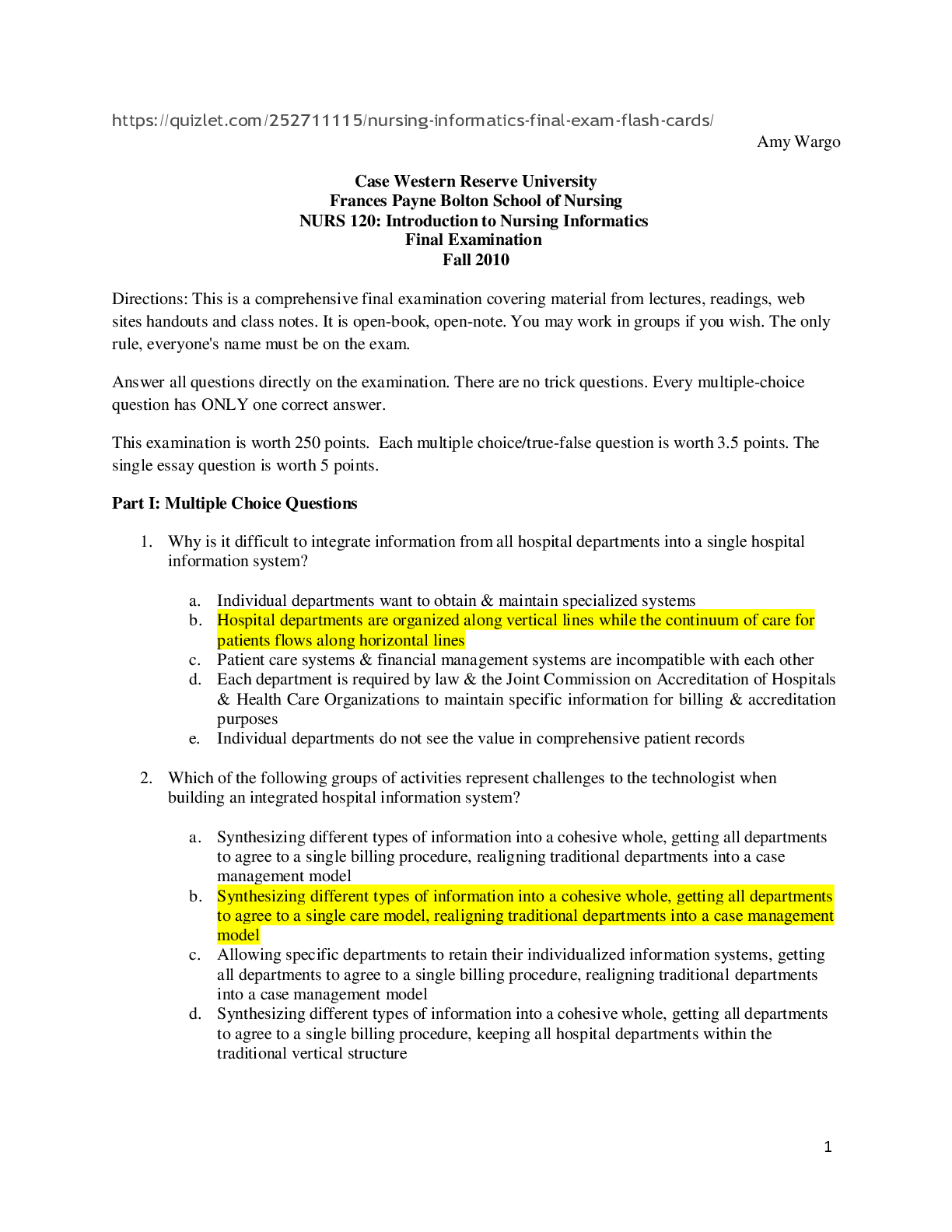

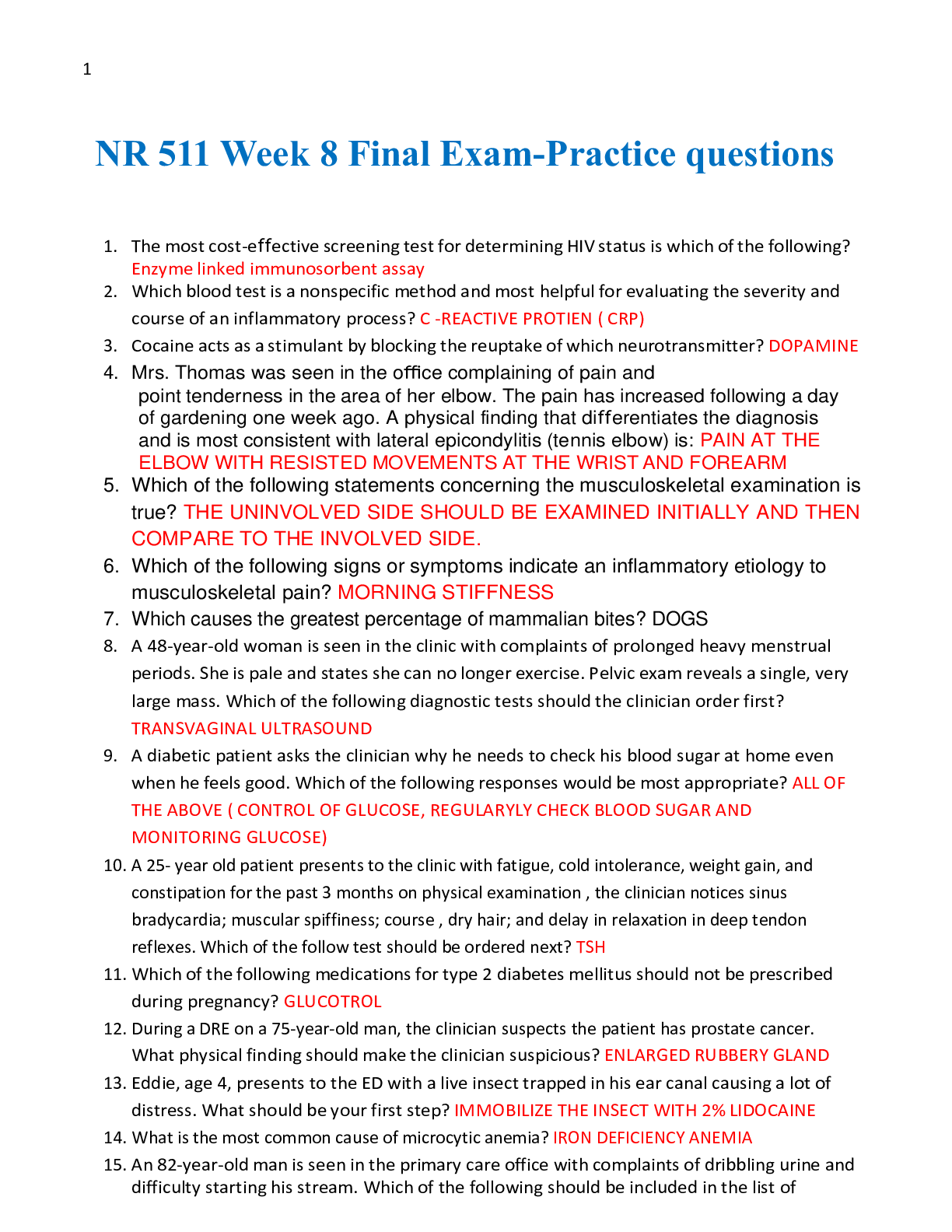

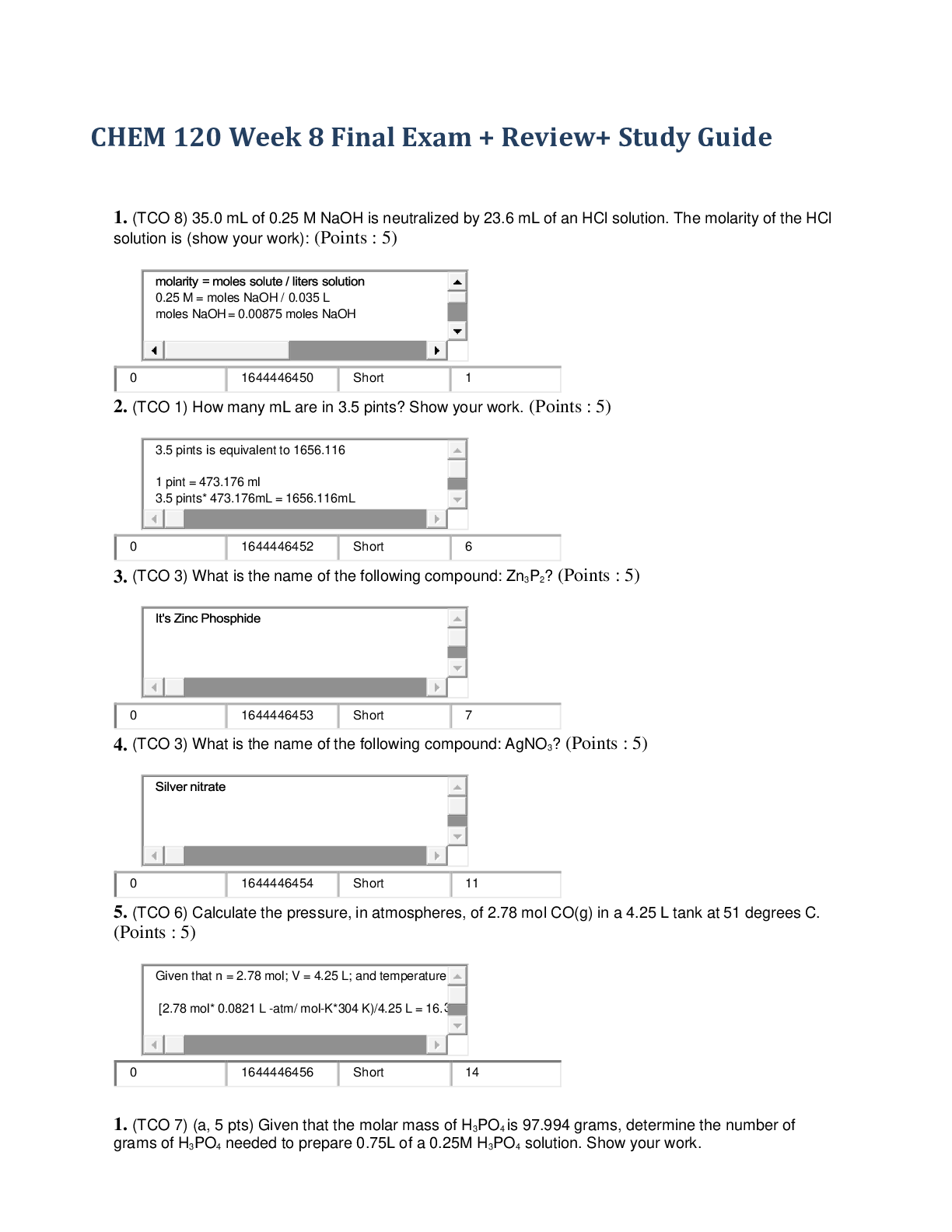

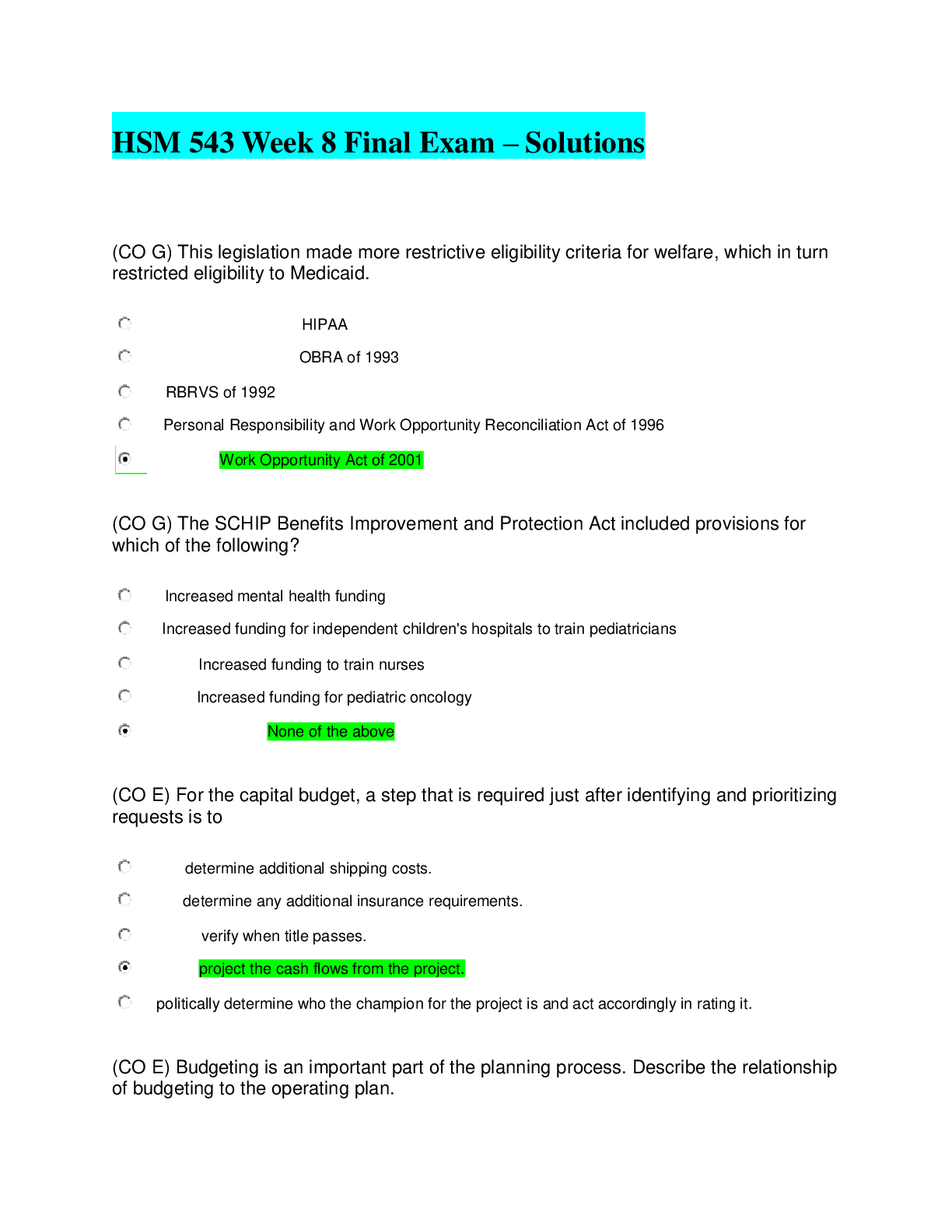
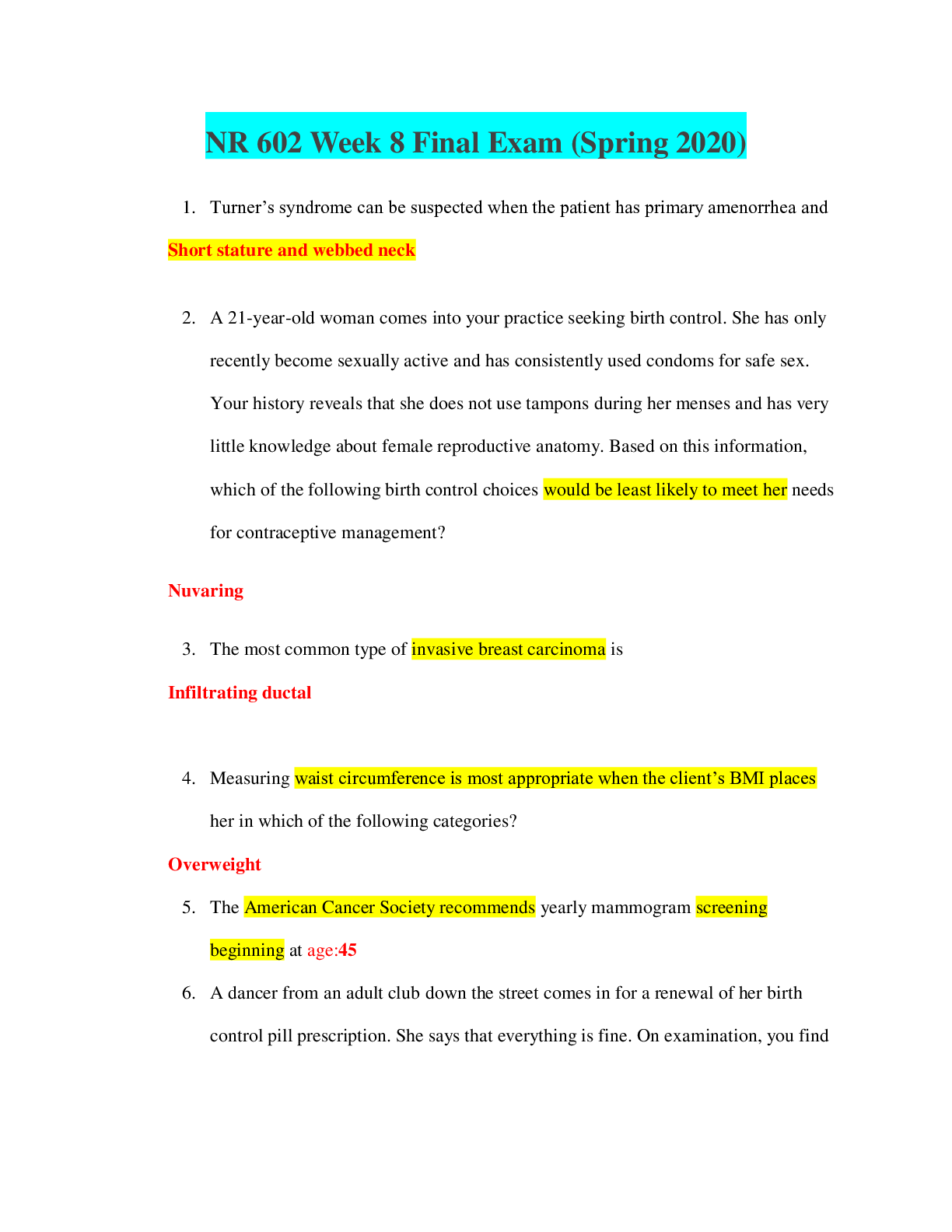
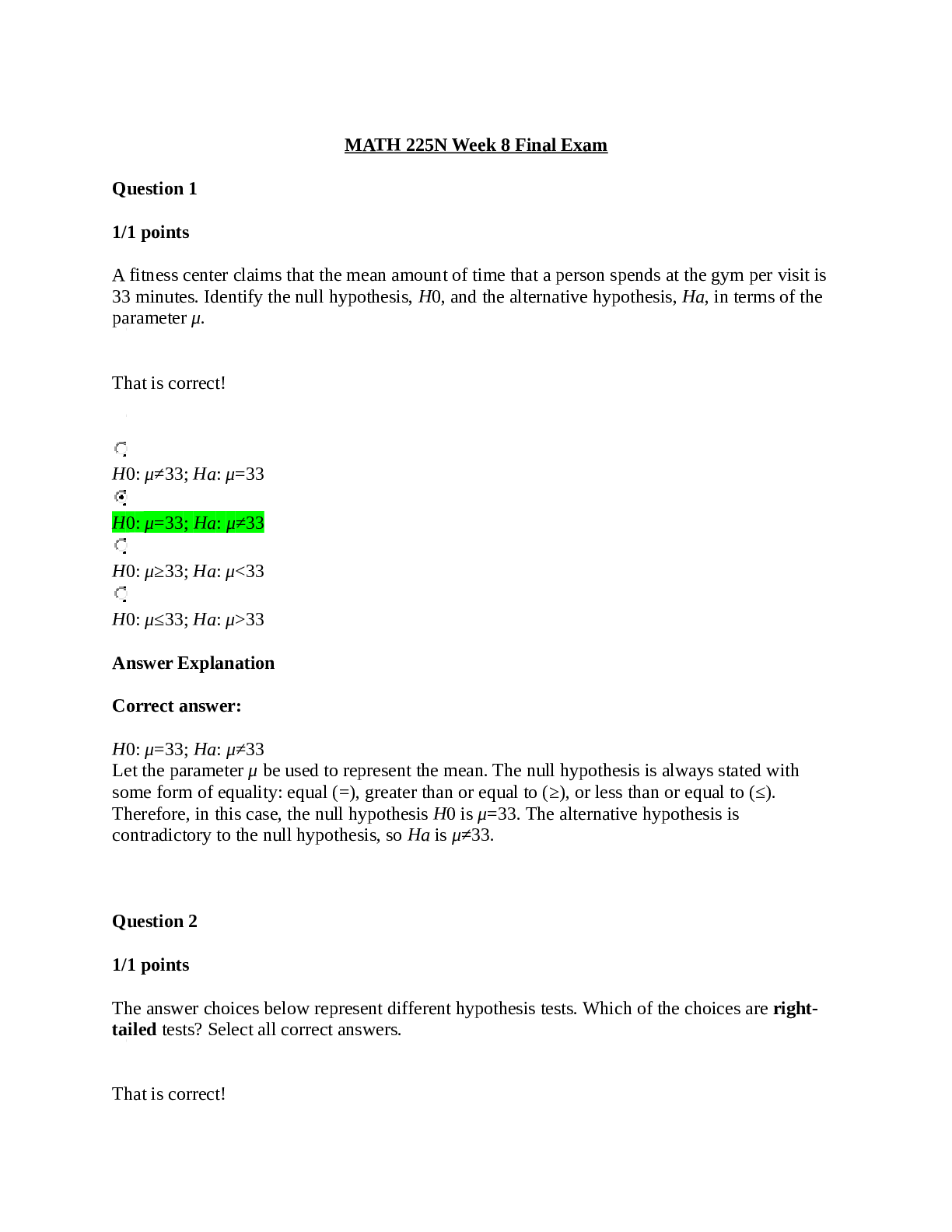
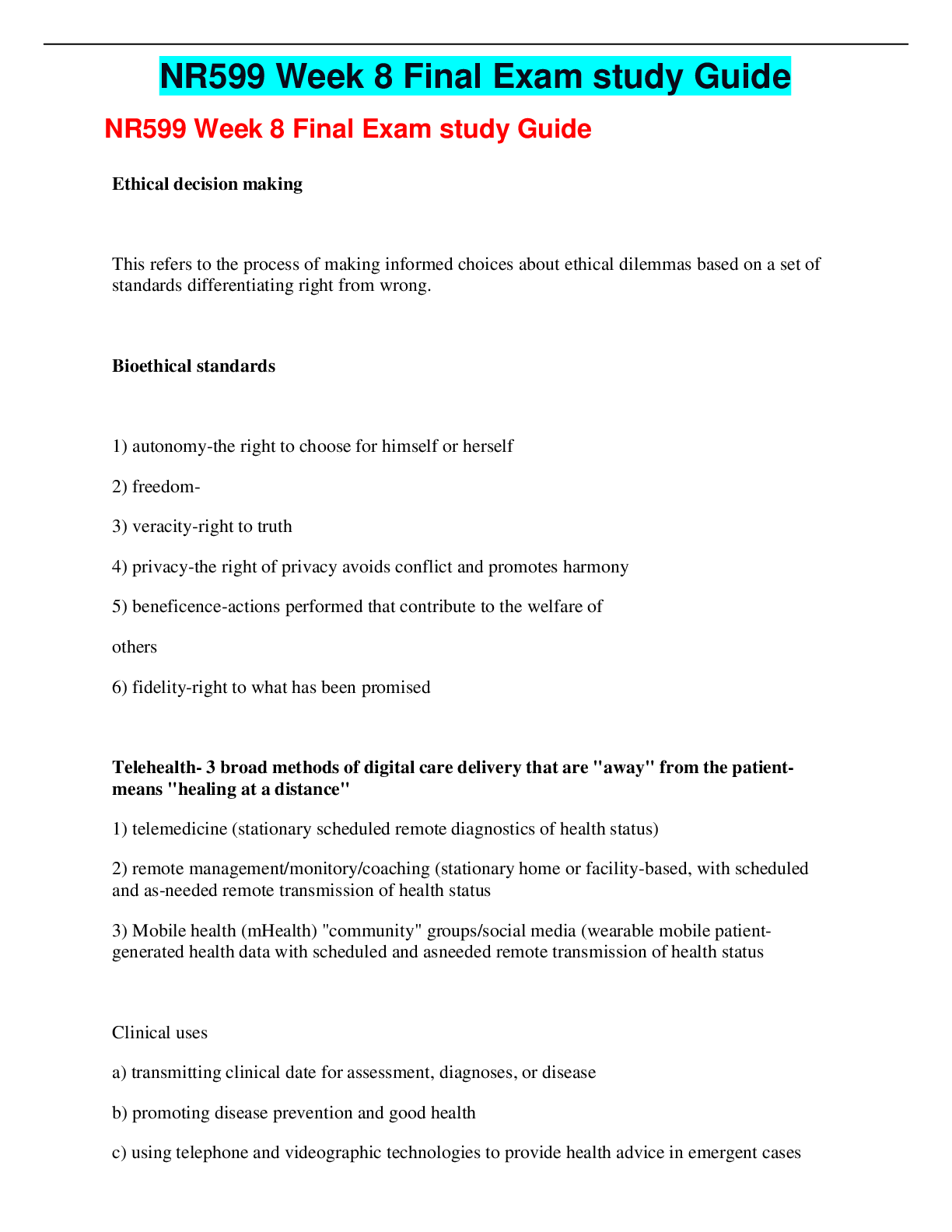
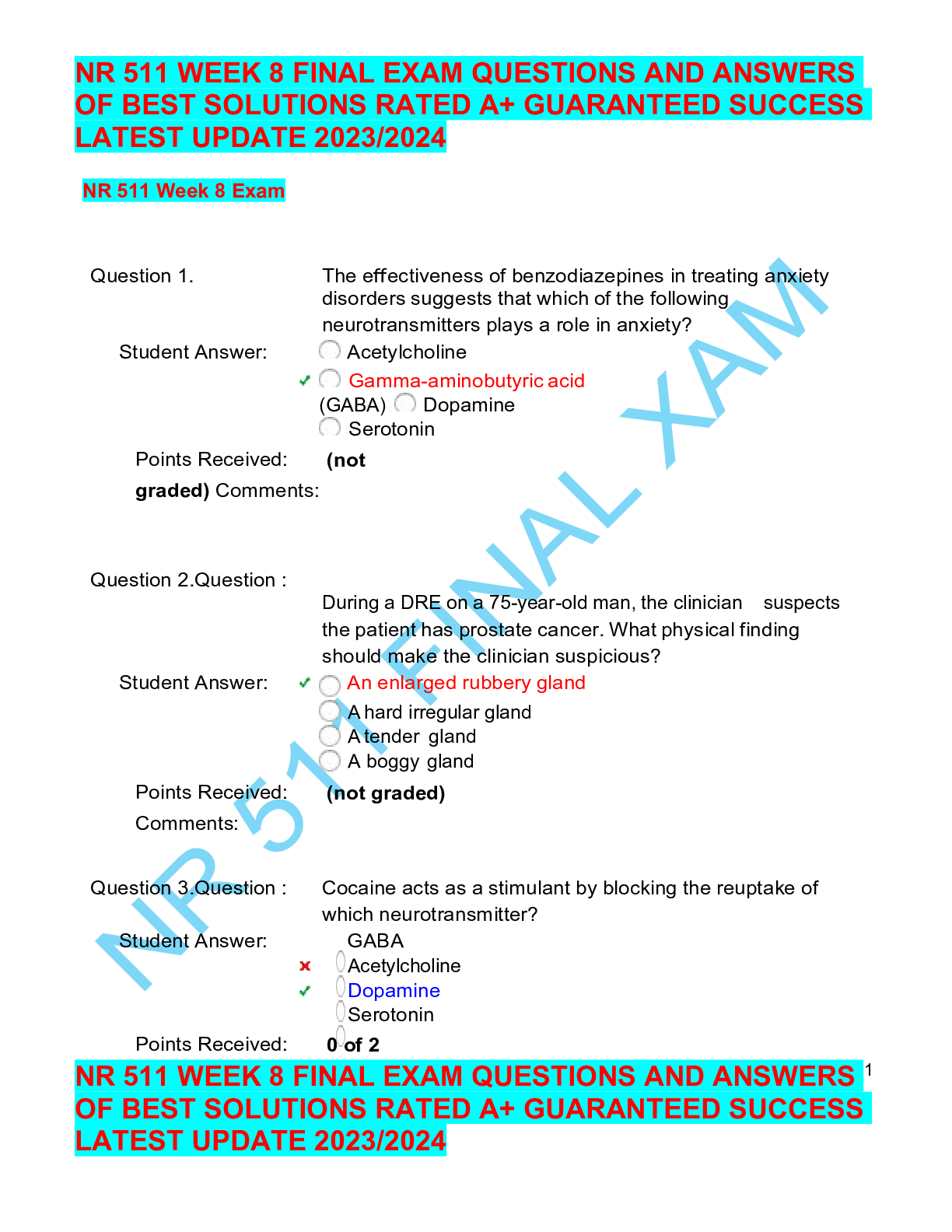



.png)
